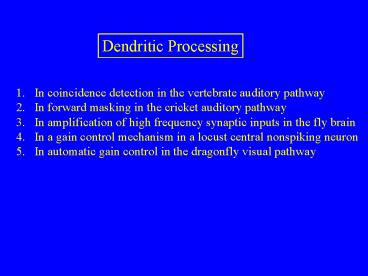Dendritic Processing - PowerPoint PPT Presentation
1 / 19
Title:
Dendritic Processing
Description:
In forward masking in the cricket auditory pathway ... Omega neurons of the cricket prothoracic ganglion are ... dynamics in a cricket auditory neuron: an ... – PowerPoint PPT presentation
Number of Views:84
Avg rating:3.0/5.0
Title: Dendritic Processing
1
Dendritic Processing
- In coincidence detection in the vertebrate
auditory pathway - In forward masking in the cricket auditory
pathway - In amplification of high frequency synaptic
inputs in the fly brain - In a gain control mechanism in a locust central
nonspiking neuron - In automatic gain control in the dragonfly visual
pathway
2
1. Coincidence detection in the auditory pathway
Placing input from the two ears on dendrites on
the opposite side of the soma means that
nonlinear summation will prevent strong
unilateral inputs from firing the neuron but
coincident moderate inputs from the two
dendrites will sum linearly to surpass threshold
and fire the cell.
3
Computer simulations indicate that placing
synaptic inputs on dendrites increases the
differences between maximum and minimum responses
of the output neuron when inputs arrive at 0o
and 180o with respect to one another. However, at
high frequencies dendrites become a burden as
temporal precision becomes more difficult to
control (due to spike jitter in the auditory
nerves). Thus, neurons that compute time
differences In the high frequency range have
short, fat dendrites.
4
Nucleus laminaris of the chicken
5
(No Transcript)
6
(No Transcript)
7
2.Forward masking in the cricket auditory pathway
Omega neurons respond to low-intensity
chirps unless the chirps are preceded by those of
higher intensity (forward masking).
Omega neurons of the cricket prothoracic ganglion
are targets of auditory sensory neurons from ears
on the front legs.
8
Intense sound pulses increase omega action
potential frequencies that are positively
correlated with intra cellular Ca2 and
post-stimulation hyperpolarization.
Injection of Fura 2 was used to demonstrate an
increase in intracellular calcium ions in omega
neurons during periods of simulated cricket
songs.
9
A B, demonstration of the effects of high
concentration of a calcium buffer (Fura-2) upon
the post-stimulus activity of an Omega neuron.
C,D, effects of UV light upon Activity in an
omega neuron that had been Injected with
calcium-bound DM-Nitrophen. C, during a long
sound pulse, and D, at rest.
Pre-injection
Post-injection
10
3. Amplification of high-frequency dendritic
signals
CH and HS neurons are large collector cells
of the insect lobula plate. CH cells respond to
move- ment (black bars)of a grating in the visual
field with graded responses, while HS cells
respond with high resolution to the temporal
variations in light Intensity.
The rapid responses of HS cells depend upon
voltage gated ionic currents, as shown by
injection of hyperpolarizing current.
Hyp. current
11
HS cells have fast activating, voltage-gated
sodium currents. Their identical amplitudes
at distant parts of the dendritic arbor are not
consistent with purely passive (electrotonic)
spread.
HS
12
HS cells preserve the temporal qualities of a
visual stimulus more faithfully than CH cells at
high stimulus velocities.
13
4. Adaptive gain control in locust nonspiking
central neurons
Oscillating current injected into NCNs produce
voltage responses that depend upon the membrane
potential level.
Synaptic potentials (inhibitory) produced by NCNs
are continuous.
Synaptic transfer functions from NCN-motor
neuron synapses. The function has a maximum slope
at a presynaptic potential of around 50 mV, that
is within the range of NCN membrane potential
where it is least responsive to synaptic input.
Thus, synaptic efficacy is maintained in the face
of varying mem- brane potentials
14
The effect of these opposing synaptic mechanisms
is stability of the inhibitory influence
(synaptic transfer) of the NSN upon the
motorneuron.
15
5. Gain control in the visual pathway
Retinula cell
LMN
light
16
Response-intensity functions for the retinula
(photoreceptor) cell. Light adaptation to
in- creasing background levels shifts the
functions progressively to the right, but
the sensitivity to incremental changes in
intensity remains.
Level 3
Level 2
Dark adapted
Background level 1
17
Response-intensity functions for the LMN are
characterized by higher contrast efficiency
Bkgrnd Level 1
2
3
Dark adapted
18
Retinula cell
LMN
light
19
References
Agmon-Snir H, Carr CE, Rinzel J. 1998. The role
of dendrites in auditory coincidence detection
Nature 393268-272. Haag J, Borst A. 1996.
Amplification of high-frequency synaptic inputs
by active dendritic membrane processes.
Nature 379 639-641. Laughlin SB, Hardie RC.
1978. Common strategies for light adaptation in
the peripheral visual systems of the fly ando Ca
dragonfly. J Comp Physiol 128319-340. Laurent
G.1993. A dendritic gain control mechanism in
axonless neurons of the locust, Schistocerca
americana. J Physiol 470 45-54. Sobel EC, Tank
DW. 1994. In vivo Ca2 dynamics in a cricket
auditory neuron an example of chemical
computation. Science 263823-826.































